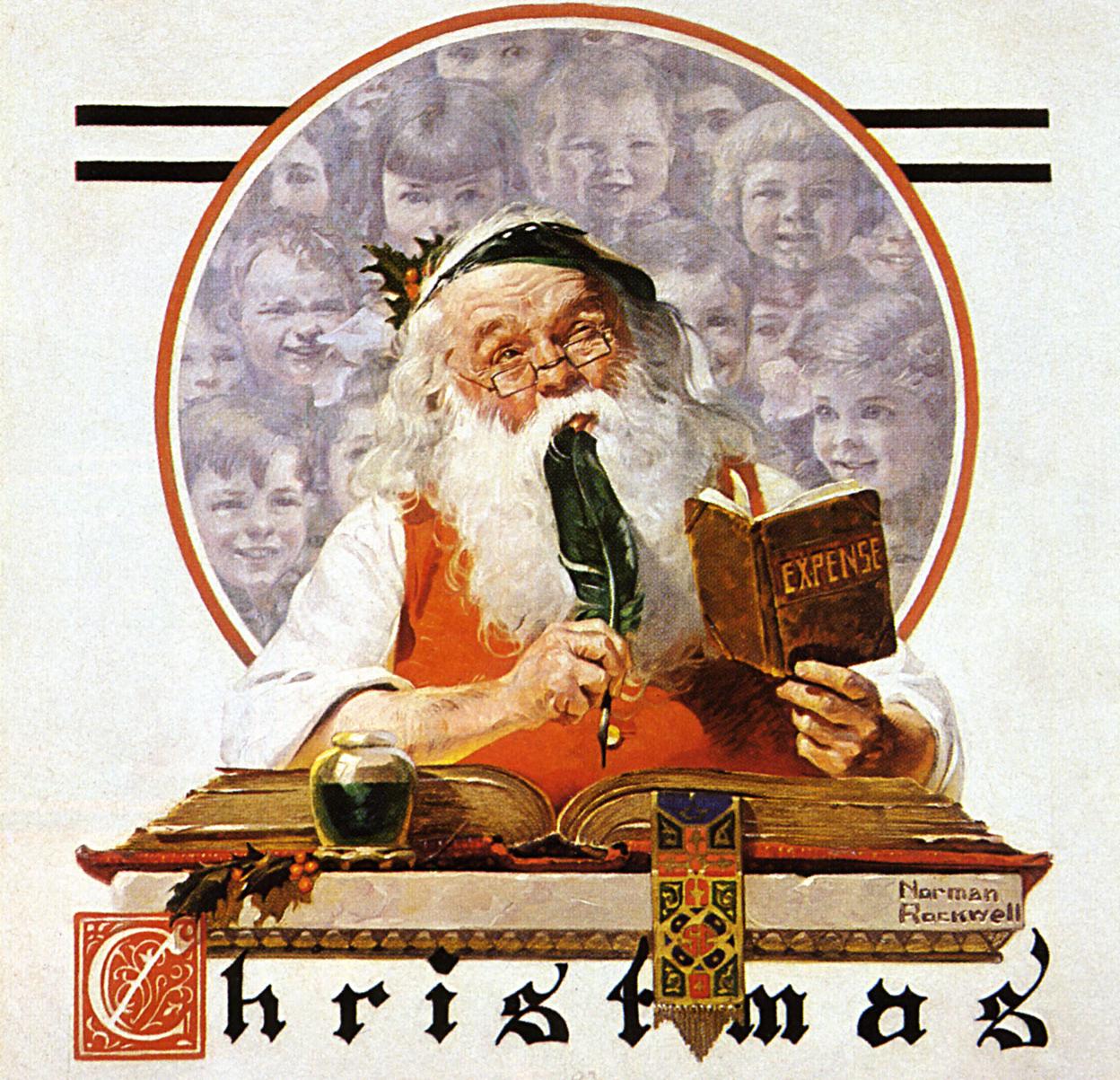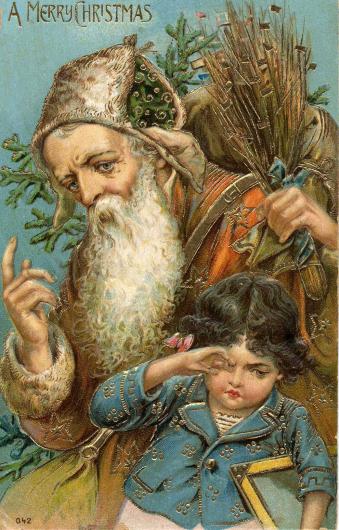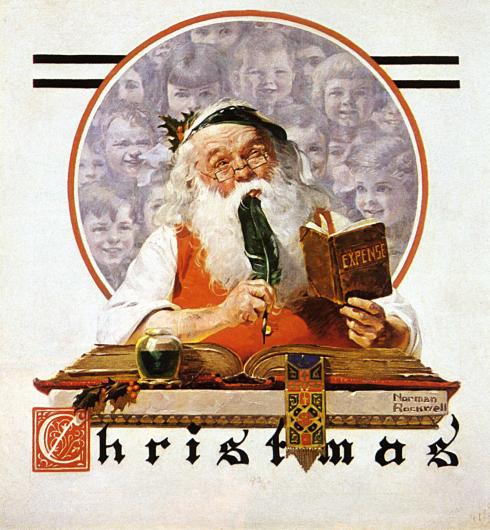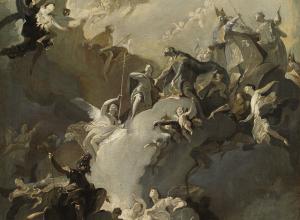
Santa Claus hasn’t always been the jolly, red-suited, grandfatherly gift-giver with a reindeer-drawn sleigh we all know and love. Depictions of Santa have evolved over time, influenced by stories and legends about St. Nicholas, Sinterklaas, and Father Christmas, and perpetuated by centuries of gift cards, stories, advertisements, posters, and movies. Here’s a look at how art has reflected the changing face (and waistline) of Santa over time.

In this vintage World War II poster, Santa is dressed in his now-signature red fur-trimmed suit and hat and is hefting a bag full of biplanes and tanks. His red-mittened hand holds a note stating these things are for the boys on the front, to be delivered to Axis leaders Hitler, Tojo, and Mussolini. This poster uses Santa to bring hope, Christmas cheer, and a feeling of support to the troops. It seems to say things have to go well with Santa on our side, reflecting how entrenched Santa is in the modern psyche.

Now firmly his own mythological figure, Santa was originally inspired by the fourth century Greek bishop, Saint Nicholas of Myra, a man renowned for his generosity and kindness. One of the most popular of his stories involves him anonymously throwing dowry money into the house of three impoverished sisters and having it land in the stockings they had hung out to dry.
St. Nicholas became the patron of children, and his feast day is celebrated on December 6th. St. Nicholas grew to be the most popular saint of the Renaissance. Even though his veneration was discouraged after the Protestant Reformation, he remains popular.

In the Netherlands and Belgium, St. Nicholas became Sinterklaas, a skinny elderly man with flowing white hair and a beard, dressed in red, fur-trimmed robes with the miter of a bishop. In mid-November, Sinterklass “arrives” on a steamboat from Spain and parades through towns on an impossibly fast white horse who is capable of flight, bearing a large red book with the names of all the good children, and distributing candy and special ginger cookies.
On the night of St. Nicholas’ Eve, December 5th, he delivers presents, flying from rooftop to rooftop and going down the chimney to deposit presents in the shoes left by children’s beds and taking the snacks left for his horse.

Father Christmas is the English personification of Christmas. Now synonymous with Santa Claus, the folkloric roots of Father Christmas go back to at least the sixteenth century. A tall bearded man, clad in fur-trimmed robes, he embodies Christmas cheer. Associated with peace, joy, feasting, and revelry, Father Christmas brings presents to good children and punishes the bad ones. During the Victorian era, there was a resurgence of interest in Father Christmas, as epitomized by this colorized edition of John Leech’s engraving for Charles Dickens' Ghost of Christmas Present.

New Yorkers embracing their Dutch roots started popularizing stories of Santa Claus, an Americanization of Sinterklaas, in the early 1800s. Washington Irving’s satirical Knickerbocker’s History of New York, published in 1809, mentions Santa Claus numerous times, reflecting Santa’s growing popularity with the public. An illustrated poem, Old Santeclaus with Much Delight, published in 1821 by William B. Gilley, was the first published description of Santa Claus using a reindeer-drawn sleigh to deliver presents on Christmas Eve.

Two years later, the current conception of Santa Claus as a “jolly old elf” was popularized by Clement Clarke Moore’s now-famous poem A Visit From St. Nicholas, otherwise known as Twas The Night Before Christmas. First published anonymously in 1823, Moore later claimed authorship in 1837. Thomas Nast’s 1881 illustrations of Moore’s poem, published all across the US after the Civil War, have become iconic and helped irretrievably wed Santa Claus to Christmas in the popular imagination.

Depictions of Santa have continued to vary. This charming black and white illustration is from Rebecca Stoneroad’s 1898 book, Gymnastic Stories and plays for primary schools; physical exercises for the first two years of school. The opposite of Moore’s Santa, with a belly that jiggled like a bowl full of jelly, this fit Santa gets quite a workout hauling presents and climbing chimneys.

This anonymous 1900-1909 greeting card illustrates Santa’s costume had yet to be standardized. While his coat is red, he’s wearing a furry green hat with ear flaps, not the soon-to-be iconic pointed red cap. The switch he’s holding and the crying child are evidence of his association with the punishment of bad children, something most modern depictions gloss over.

The first successful humor magazine in the United States, Puck was known for colorful cartoons, caricature, and political satire. Founded in 1871, Puck was published until 1918. This somewhat satirical cover depicts Santa in his now-familiar fur-trimmed hat and suit, engaged in the very unsaintly activity of kissing a pretty girl under the mistletoe.

Norman Rockwell’s 1920 picture of Santa cements the red outfit and pleasantly plump physique associated with Santa Claus in the popular imagination. This benevolent, elderly man squints into the distance while going over his account books, a circle of smiling children superimposed behind him. Dressed in a slightly straining red waistcoat, with a sprig of holly in his hair, Rockwell’s Santa is undeniably festive and kind, irrevocably establishing him as the beloved gift-bringer of childhood Christmas dream.

In this vintage World War II poster, Santa is dressed in his now-signature red fur-trimmed suit and hat and is hefting a bag full of biplanes and tanks. His red-mittened hand holds a note stating these things are for the boys on the front, to be delivered to Axis leaders Hitler, Tojo, and Mussolini. This poster uses Santa to bring hope, Christmas cheer, and a feeling of support to the troops. It seems to say things have to go well with Santa on our side, reflecting how entrenched Santa is in the modern psyche.

Now firmly his own mythological figure, Santa was originally inspired by the fourth century Greek bishop, Saint Nicholas of Myra, a man renowned for his generosity and kindness. One of the most popular of his stories involves him anonymously throwing dowry money into the house of three impoverished sisters and having it land in the stockings they had hung out to dry.
St. Nicholas became the patron of children, and his feast day is celebrated on December 6th. St. Nicholas grew to be the most popular saint of the Renaissance. Even though his veneration was discouraged after the Protestant Reformation, he remains popular.
Megan D Robinson
Megan D Robinson writes for Art & Object and the Iowa Source.























